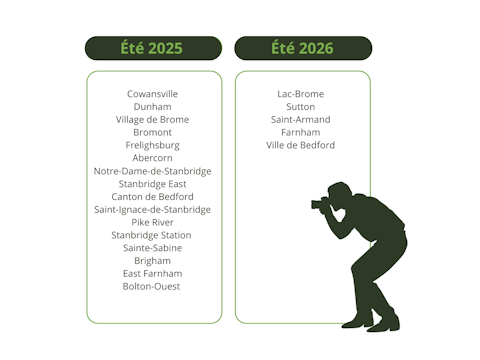
Real estate heritage inventory of the MRC of Brome-Missisquoi
Our Heritage, Our Identity, Our Pride
The MRC of Brome-Missisquoi is conducting a real estate heritage inventory in order to identify, document and better publicize buildings constructed before 1940 that bear witness to the history, identity and evolution of the territory.



What is real estate heritage?
Real estate heritage refers to all buildings, structures, or sites that hold historical, architectural, cultural, or symbolic value for a community. This can include houses, churches, barns, commercial buildings, bridges, or other constructions that bear witness to the history and identity of a territory.
Why conduct a real estate heritage inventory?
Real estate heritage is a precious but fragile resource. Whether it's a century-old church, a former commercial building, a traditional farm, or even a simple residential building typical of a certain era, these constructions can bear witness to our past and shape our regional identity.
A real estate heritage inventory allows us to:
- Preserve the memory of the territory and its evolution;
- Document and recognize the diversity of built heritage, whether emblematic or modest;
- Inform municipalities, property owners, and the public;
- Guide land development and preservation decisions;
- Determine which buildings should be subject to municipal regulations regarding demolition, occupancy, and building maintenance.
The steps in carrying out our inventory
The Quebec Ministry of Culture and Communications has established a guide to orient MRCs in their respective approaches.
Here are the four proposed components as well as the project's progress status:
- Collection and analysis of existing documentation on the territory and its buildings.
- Development of an annotated bibliography and regulatory status overview.
- Development of a database based on the assessment roll and existing documents.
- Identification of buildings to visit according to specific criteria (age, rarity, authenticity, use value, etc.).
- Historical, architectural, and landscape characterization of the MRC.
- Creation of lists of historical groups and figures, architectural types, and local specificities.
- Site visit and photographic survey.
- Documentation of architectural characteristics and physical condition of buildings.
- Analysis of each building using 19 criteria established by the Ministry of Culture.
- Assessment of the sustainability of selected buildings.
- Production of inventory sheets for each selected building.
To support the development of the inventory, certain partial inventories already completed are used as reference bases. The study on religious real estate heritage in the Brome-Missisquoi territory conducted in 2016 as well as heritage inventories carried out by the following municipalities are being utilized to enrich the ongoing work:
- Bromont
- Cowansville
- Dunham
- Frelighsburg
- Lac-Brome
- Sutton

Visit schedule
Between June and October 2025, professionals from the Bergeron-Gagnon firm will go into the field to validate certain preliminary observations, photograph buildings of potential heritage interest, assess the condition and sustainability of buildings, and document buildings in their environment. They will visit only the exterior of buildings (no entry into buildings).
Property owners of buildings targeted by these visits are notified in advance by the MRC.
What does it mean to be the owner of a building with heritage value?
The inventory is primarily a knowledge tool that aims to document and promote the real estate heritage of the territory. However, being listed can:
- facilitate access to certain grant programs;
- allow municipalities to adapt their urban planning tools;
- can contribute to enhancing a property's value by highlighting its historical or architectural importance
If your building is selected for the inventory, you will be subject to two municipal regulations:
- Building demolition regulation
- Occupancy and maintenance regulation
It should be noted that listing a building in the inventory does not confer "heritage" status under Quebec's Cultural Heritage Act. Only properties classified by Quebec's Ministry of Culture or designated by a municipality have protected status.
FAQ
It's possible. The MRC is implementing several communication actions to inform property owners in advance of buildings targeted for a visit. Each property owner whose building is targeted for a visit has received or will receive a letter from the MRC informing them of this visit.
Several hundred buildings will be visited as part of the development of the real estate heritage inventory for the Brome-Missisquoi MRC. These buildings are selected according to several criteria including: their year of construction, their appearance, their rarity, or their connection to significant elements of the territory. Only the exterior of buildings will be photographed and analyzed. No visits or photos will be taken inside private buildings. No individuals will appear in the photos and if license plates should appear, they will be blurred.
When the built heritage inventory comes into effect (in 2026), and if your building is included, it will be subject to two municipal by-laws:
- Demolition by-law: If you wish to demolish a building listed in the inventory, you must go through a decision-making process. Your request must first be evaluated by your municipality’s demolition committee. Then, your request will also require approval from the MRC.
- Occupancy and maintenance by-law: You will be required to maintain your building to prevent its deterioration. This will not impact any renovations you wish to undertake. It’s important to note that being listed in the inventory does not grant the building a “heritage” status under Quebec’s Cultural Heritage Act. Only properties that are officially classified by the Ministry of Culture of Quebec or designated by a municipality are granted protected status.
To learn more about the current regulations, please contact your municipality’s urban planning department.
No. The inclusion of a building in the MRC’s built heritage inventory does not have a direct legal impact on its status. It is not an official designation under the Cultural Heritage Act, but rather a tool for documentation and recognition.
Please contact your municipality to find out whether a local grant program is currently in place.
At the regional level, the MRC does not currently offer a grant program. However, based on specific eligibility criteria, some property owners may qualify for the RénoRégion program.
At the provincial level, certain programs may be available. For religious buildings, you can contact the Conseil du patrimoine religieux du Québec. For other types of heritage buildings, please contact the Ministry of Culture.
If the building is simply listed in the inventory, no special clause should be required in the deed of sale. However, if your municipality adopts a heritage designation by-law under the Cultural Heritage Act, certain legal preservation obligations may apply to the building, regardless of the owner. Please contact your municipality for further details.
Before undertaking any work on your building or property, we encourage you to contact your municipality.
Demander à ChatGPT
Being listed in the inventory should not automatically change the property’s assessed value. The value is determined by certified appraisers based on objective criteria such as the building’s condition, use, and the local real estate market.
Listing in the inventory should not affect the taxable property value and therefore should not impact your municipal tax bill.
Being listed in the inventory should not result in increased insurance costs. If you notice a rise in your premiums specifically related to the inventory listing, we encourage you to contact the MRC. For any questions regarding the insurability of your older home, you can consult the Insurance Guide for Owners of Historic Homes (French only).
Contact
Do you have information, photos, or historical documents that you would like to share with us? Don't hesitate to write to us via realisonsbm.com
Useful links and documents
Contact person

